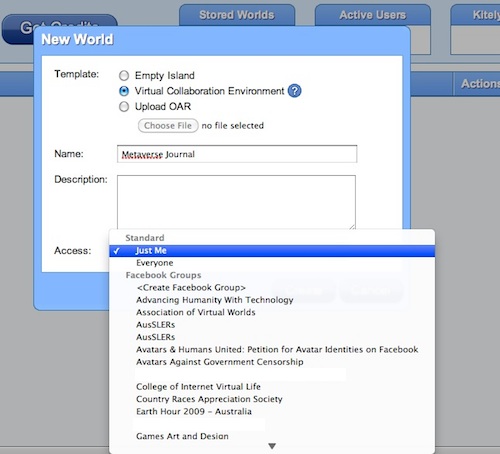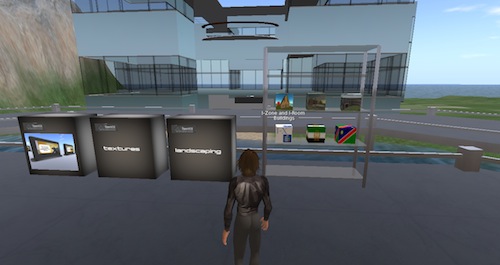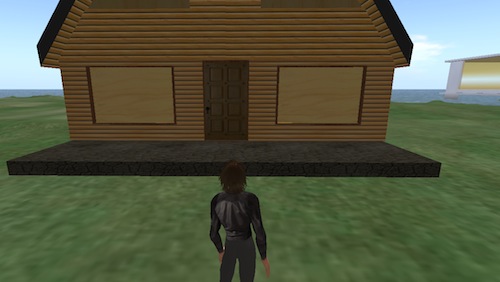Like a lot of virtual worlds observers, I’ve written repeatedly on the need for virtual worlds like OpenSim and Second Life to be simpler to use – ideally web browser based. Kitely, a project underway since 2008, takes a big step toward achieving that by making the establishment of an OpenSim grid nearly as simple as it gets.
It took me under ten minutes to get set up in Kitely. Here’s how:
1. Log in via Facebook Connect.
2. Install the Kitely plugin (Mac users note: Safari or Opera aren’t currently supported by the Kitely plugin at present, you’ll need to use Firefox or Chrome).
3. Create a world and choose if you want to invite anyone from Facebook groups you are part of:

4. Type a name, optional description and type of world you want to start with.
5. Click on ‘Enter World’ and your SL browser will launch (Mac users again – there’s a known bug whereby your username and password are all entered in the Name field of the SL browser – you just need to type in that password and delete it from the end of your name)
5. Voila – you’re now on your own island / collaborative space:

6. Three minutes later and I had my venerable log cabin rezzed on my island:

Kitely is currently in beta, and the currency used is called a KC. As part of the beta you get 50 KCs currency to start with and it costs 1KC per day to keep each world you create. On the proposed maximum discount structure that works out at US ten cents per month. It’s an attractive proposition for someone not wanting the hassle of creating their own grid from scratch and its more than competitive with other providers. The support functionality is fairly well set up and responsive from what I’m seeing.
There’s still plenty of kinks to iron out but Kitely is a superb snapshot of what is going to be required for wider adoption of virtual environments: simplicity and integration with other platforms. I’d be interested to hear from anyone who has experience in creating content in OpenSim as to your thoughts on comparability to other offerings. It’s also worth having a read through the Kitely FAQ, which covers a lot of stuff including the approach to intellectual property (essentially the same as Second Life) and the Terms of Service.
Thanks to a number of Metaverse Journal twitter followers for the heads-up.
Update: With thanks to reader Psx_kai, who pointed out a key fact I’d missed in the story. The pricing I described was correct but didn’t include the extra charge of US$0.20 per minute for each visitor to your world. That’s certainly going to get pricey after a while although it seems it’s going to be an option to earn a fair whack of free KCs. On the upside, the ‘pay for what you use’ model is something that can work well for those wanting intermittent events without the ongoing higher monthky costs on say Second Life.
Did you really read the full story?
“How much does it cost me when people visit one of my virtual worlds?
Each user who visits one of your virtual worlds will cost you 1 KC per minute (which equals to $0.20 per hour when buying KC at our maximum discount level).”
That’s the opposite of cheap.
Hi Psx_kai: I had totally missed that price point for some reason, story updated to reflect it 😉
Thanks!
Step 2 “Install the Kitely plugin” is easier said than done.
Um, that “create a world” step sounds like a doozy.
So first you have to lease or have a server, and configure it, have a DSL or other broadband line with the right graphics card, and then you have to figure out how to get the open sim software running such as to “create a world”. You have to get a sim, terraform it, put content on it, and save it as the OAR file. There are likely 100 steps within that little phrase.
Metaplace was trying to make that concept simpler. You really could download their browser, with a few simple steps enter their welcome area, and on the browser, start little worlds that were like sims that had expansions to them. Then you could share it in various ways.
But open sim isn’t simple like that.
Hi Prok that’s the point though, Kitely did all the creation behind the scenes. I just clicked a button and waited 20 seconds or so and my world was created. That’s what impressed me the most.
Some random calculating:
Second Life average concurrency now down to just 49,000 people
Link: http://www.metaverse-business.com/concurrency_y.php
That’s 35 million avatar-hours a month.
With Kitely, that adds up to just around $7 million a month in hosting costs.
SL has about 25,000 private regions — that’s just over $7 million in hosting costs for users.
So, *on average* Kitely costs about exactly the same as Second Life. This means that half of all region owners (the ones that see less traffic) will do better with Kitely, and the ones that see more than average traffic would do worse with Kitely.
Probably best use case is for small groups holding occasional meetings, and content creators that want to create their stuff outside of Second Life, then import it for sale — and need a lot of space for builds and object warehouses.
— Maria
Hi Maria,
The average may be true but that doesn’t mean that the split is half above average and half below average.
For example lets say there are 100 regions with 10 avatar-hours and 1 region with 1000 avatar-hours, the average is (100*10 + 1*1000) / 101 = 19.80 avatar-hours even though there are 100 regions using less than that average (just 10 avatar-hours) and only 1 region using more.
In this scenario more than 99% of regions are forced to subsidize the cost of just 1 heavy-use region. The Kitely model makes better financial sense for all but the top few % of regions.
You’re absolutely right. I don’t know where to get the distributions numbers, though.
Neither do I. I doubt they would publish them… That would just send users running to Kitely 🙂
Things depend on the use case…
I sure that there are comparative opportunity cost use cases that operate under your threshhold, like mass market newbies, who later get enhanced needs and demands for extended use cases… even up to high-performance scaled grids using grid computing technology.
Interesting, however if you want to run your own dedicated virtual world server in a data center, you’ll want to check out my “How to Build Your Own Virtual World” article at
http://rocketvirtual.com
It’s the most comprehensive yet on setting up the Diva Distro version of opensim.